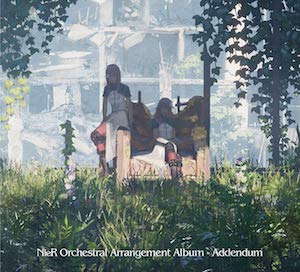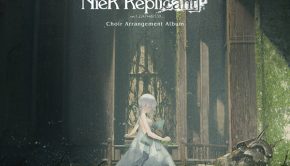NieR Orchestral Arrangement Album – Addendum
 |
Album Title: NieR Orchestral Arrangement Album – Addendum |
| Record Label: Square Enix Music |
|
| Catalog No.: SQEX-10765 |
|
| Release Date: March 25, 2020 |
|
| Purchase: Buy at CDJapan |
Overview
NieR Orchestral Arrangement Album – Addendum is an album of orchestral arrangements intended for the NieR Theatrical Orchestra 12020 concerts celebrating the 10th anniversary of the NieR series. It is the second official orchestral arrangement project for the series, coming two years after the first set of albums. This new album is evenly divided into 5 tracks each from NieR Gestalt & Replicant and NieR: Automata. The arrangements, handled this time only by Sachiko Miyano and Kosuke Yamashita, are aimed to be more faithful to the originals, especially in comparison to the previous albums. To this end, many of the tracks feature solo vocalists Emi Evans and J’Nique Nicole, who both performed on the original soundtracks. The first-press of the physical album includes a special bonus disc with three additional arrangements that were not made available digitally.
Body
The first half of the album is dedicated to NieR Gestalt & Replicant, and it begins with “Ashes of Dreams”, featuring both Evans and Nicole. The orchestral arrangement is disappointingly not very different from the many other soundtrack and live versions of the track, but Nicole’s vocal is a wonderful addition to the mix, as she shows a few new colours of her versatile voice. I also loved the sparing but effective vocal harmonies. The orchestra and vocals also feel a little more dramatic, so altogether I enjoyed this retread much more than I expected to. The duo return for “Song of the Ancients” which starts with Evans singing solo accompanied only by a harp, styled after the “Devola” arrangement from the original soundtrack, before launching into the bombastic “Fate” version after the first chorus. Unfortunately the first portion the track is lacklustre, as the harp isn’t as emotional as the original guitar, nor does it even make use of the sweeping arpeggios that the instrument is known for. This section easily could have been improved by a gradual introduction of other instruments in order to provide some counterpoint and ease the abrupt transition into the second portion. The “Fate” side doesn’t really fare much better, since it lacks the original’s interesting percussion, and doesn’t try do anything that the original didn’t. The track is still alright in itself since the originals that it is based on are so excellent, but it feels unnecessary.
The remaining tracks from the first half do not feature the solo vocalists. “Emil” is another track that begins quietly and sombrely before escalating to the battle version in the second half. Thankfully the arrangement isn’t merely a reproduction of the soundtrack versions, as it introduces some new counterpoint and varies the instrumentation, though it never strays far from the original melody and harmony, and it even works in the additional melody from “Emil / Despair.” The first half is appropriately thick with emotion, helped by the underlying piano, while the second half is urgent and epic. The first orchestral version was a highlight for me, and this one is another welcome addition. The new arrangement for “Kainé” brings back the piano line from the original while a solo violin leads with the main melody throughout, providing a focus that the first orchestral arrangement did not have. The track begins very intimately before the rest of the strings sneak in, providing lovely textures along the way. Although it stays close to the original, the few variations that it makes to the melody and accompanying figures are enough to justify its existence, and the track is undeniably very beautiful. Then there is “Deep Crimson Foe” which actually begins with “The Ultimate Weapon” before launching into the namesake. “The Ultimate Weapon” is very successfully translated from its a cappella original to piano and strings, not really changing any of the lines of music, but becoming much darker and moodier just through the instrumental shift. The “Deep Crimson Foe” proper is less interesting since it is so close to its original, though there are some small variations that add a bit more punch.
The NieR: Automata tracks begin with “City Ruins”, here much simpler than its previous orchestral arrangement in harmony, though still thick and lush in orchestration. Again the original piano line is brought back to ground the track, while the different instrument sections handle the main melody in turn. The most interesting of these is the choral section, particularly with the lower male voices. Unfortunately the arrangement is a bit middling otherwise, taking too long to build and not doing anything else interesting other than varying the instrumental focus. “Copied City” makes more of an impression, arranged here for the first time. The song sounds great with a full orchestra, and Miyano knows just how to fill out the arrangement to make it sound more at home in its concert hall setting. As the track progresses, Miyano shifts around and multiplies the musical lines, keeping things recognizable while developing the song gradually to a dizzying climax to become one of my favourites from the project. The other new arrangement is “Crumbling Lines – Front”, which unfortunately is too safe as an arrangement, and it doesn’t help that it is one of the weaker compositions of original soundtrack. Some attempts were made to bolster and crescendo the sound, but the changes feel inessential. The arrangement probably would have been more successful paired with another track.
The remaining tracks feature the solo vocalists, but unfortunately recycle previous arrangements. “A Beautiful Song” is very close to the orchestral arrangement from the first album, but now has the original vocalists present. There are a few small changes, like the subtle inclusion of a piano, or the addition of some counterpoint here and there, but the second half is still too similar to the first half. However, the simple reintroduction of Evans and Nicole makes it an improvement over the previous orchestral version, and the track is as dazzling as ever. “Weight of the World” is also nearly identical to a previous arrangement (in this case the one from NieR: Orchestra Concert 12018), differing only by including Evans. Both sing again in English, and I get the feeling that they are trying to be a bit more affected than they were when singing on the original soundtrack. The orchestral arrangement is lighter and more varied than the original soundtrack versions, but it’s largely a faceless and uninteresting accompaniment, and ultimately a disappointing note to end on.
Summary
NieR Orchestral Arrangement Album – Addendum succeeds in producing arrangements that closer to the originals, though the inclusion of recycled arrangements is a letdown. I generally preferred Miyano’s arrangements much more than Yamashita’s, as Miyano managed to find creative outlets while retaining each track’s identity. I was surprised to find that even after many other arrangements and performances of these tracks, I was still not entirely tired of these songs, and could appreciate the new things that some of the arrangements brought to the table. Given the recycled arrangements, the cheaper digital edition appropriately priced, though that means missing out on the interesting arrangements on the bonus disc included only with the physical edition. Fans of the series who are looking for faithful orchestral arrangements should find enough to like here, even though repetitions and safe arrangements keep the album from being great.
Do you agree with the review and score? Let us know in the comments below!
3.5
Posted on March 27, 2020 by Tien Hoang. Last modified on March 31, 2020.














